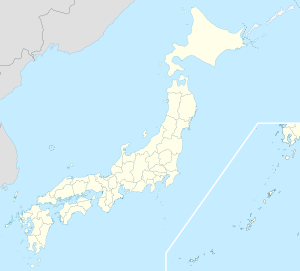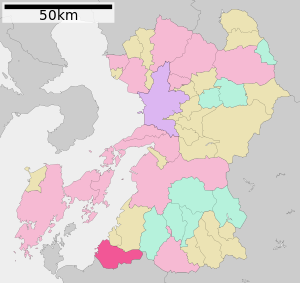Minamata
| Minamata-shi 水 俣 市 |
||
|---|---|---|
| Geographical location in Japan | ||
|
|
||
| Region : | Kyushu | |
| Prefecture : | Kumamoto | |
| Coordinates : | 32 ° 13 ' N , 130 ° 25' E | |
| Basic data | ||
| Surface: | 162.87 km² | |
| Residents : | 23,845 (October 1, 2019) |
|
| Population density : | 146 inhabitants per km² | |
| Community key : | 43205-9 | |
| Symbols | ||
| Flag / coat of arms: | ||
| Tree : | cherry | |
| Flower : | azalea | |
| town hall | ||
| Address : |
Minamata City Hall 1 - 1 - 1 , Jinnai Minamata -shi Kumamoto 867-8555 |
|
| Website URL: | http://www.minamatacity.jp | |
| Location Minamatas in Kumamoto Prefecture | ||
Minamata ( Japanese 水 俣 市 , -shi ) is a Japanese city in Kumamoto Prefecture on Kyushu Island on the coast of the Yatsushiro Sea , which is connected to the East China Sea by a strait . There are several thermal springs in the area that are used for bathing.
history
The city was named Shi on April 1, 1949 .
Minamata became the term for environmental damage caused by uncontrolled dumping , the chronic waste in the Yatsushiro Sea, when exhibited in the town mid-1950s, damage to the central nervous system of humans and animals mercury poisoning by untreated sewage a chemical plant of the company Chisso be returned and later became known as Minamata disease . According to current estimates, around 10,000 people were harmed and around 3,000 died.
In Minamata, 140 states agreed on the Minamata Convention in January 2013 at a United Nations conference , which was signed on October 11, 2013 in Kumamoto , Japan . The agreement provides for the worldwide monitoring and reduction of mercury emissions, especially in ore mining (especially gold mining ), from coal-fired power plants , cement works , metal works and waste incineration , and the abolition of products containing mercury such as clinical thermometers and batteries .
traffic
- Street
- National road 3 : to Kagoshima or Kitakyushu
- train
- JR Kagoshima Main Line : to Kagoshima or Kikakyushu
Neighboring cities and communities
Town twinning
sons and daughters of the town
- Tokutomi Sohō (1863–1957), Japanese historian and journalist
- Tokutomi Roka (1868-1927), Japanese writer
- Tanigawa Ken'ichi (1921–2013), Japanese folklorist




